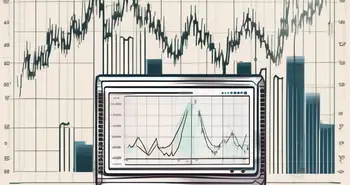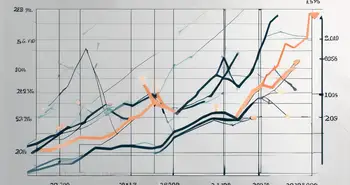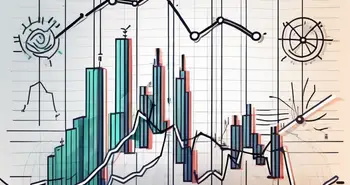The Simple Guide to Statistical Arbitrage

Statistical arbitrage is a powerful investment strategy that relies on the analysis of statistical relationships in financial markets. By identifying patterns and taking advantage of pricing disparities, investors can potentially profit from market inefficiencies. In this guide, I will walk you through the basics of statistical arbitrage, the mechanics behind it, the tools and techniques involved, and the impact of market conditions on its performance. So, let's dive in and explore the fascinating world of statistical arbitrage!
Understanding the Basics of Statistical Arbitrage
Before we delve into the intricacies of statistical arbitrage, let's start with a clear definition and overview of this strategy. In essence, statistical arbitrage involves exploiting the observed relationships between different financial instruments to generate profits. By analyzing historical data, investors can identify moments when the prices of related assets deviate from their statistically expected levels. These deviations create opportunities for profit by taking simultaneous long and short positions in the assets.
Statistics play a crucial role in statistical arbitrage. Through rigorous quantitative analysis and modeling, investors can develop strategies that aim to predict pricing discrepancies with a high degree of accuracy. These strategies rely on statistical techniques such as regression analysis, correlation analysis, and mean reversion.
One key principle of statistical arbitrage is the principle of mean reversion. This principle suggests that over time, asset prices tend to move back towards their statistical mean or average. By identifying when an asset's price deviates significantly from its mean, investors can take advantage of the expected price correction.
Another important aspect to consider in statistical arbitrage is the concept of risk management. Given the complex nature of financial markets and the inherent uncertainties involved, effective risk management strategies are essential for successful implementation of statistical arbitrage. Investors need to carefully assess and mitigate various types of risks, including market risk, liquidity risk, and operational risk, to safeguard their investments.
Furthermore, technological advancements have significantly impacted the landscape of statistical arbitrage. The use of high-frequency trading algorithms and sophisticated data analytics tools has enabled investors to execute trades at lightning speed and analyze vast amounts of data in real-time. This technological evolution has both enhanced the efficiency of statistical arbitrage strategies and intensified competition among market participants.
The Mechanics of Statistical Arbitrage
So how does statistical arbitrage work in practice? To begin, investors need to identify potential arbitrage opportunities. This involves carefully analyzing vast amounts of historical data to spot relationships between assets that can be exploited. By using sophisticated algorithms and mathematical models, investors can pinpoint moments when prices diverge from their expected values.
Once potential arbitrage opportunities have been identified, the execution phase begins. Investors will simultaneously buy the undervalued asset and sell the overvalued asset to capitalize on the price convergence. This process involves coordinating multiple trades across different financial markets and monitoring the portfolio in real-time to ensure risk is appropriately managed.
Risk management is crucial in statistical arbitrage. As with any investment strategy, there are risks associated with statistical arbitrage, such as unexpected market fluctuations or ineffective modeling. Successful practitioners of statistical arbitrage employ robust risk management techniques to control downside risk and maximize potential profits.
Furthermore, statistical arbitrage strategies can be categorized into different types based on their underlying principles. One common approach is mean reversion, where investors bet that asset prices will eventually revert to their historical averages. Another strategy is momentum trading, which involves capitalizing on the continuation of existing price trends. Understanding these different strategies is essential for investors looking to diversify their statistical arbitrage portfolios.
Moreover, technological advancements have played a significant role in the evolution of statistical arbitrage. High-frequency trading (HFT) algorithms now enable investors to execute trades at lightning speed, taking advantage of fleeting market inefficiencies. Additionally, machine learning and artificial intelligence are being increasingly utilized to enhance the predictive capabilities of statistical arbitrage models, giving investors a competitive edge in the fast-paced world of financial markets.
Tools and Techniques in Statistical Arbitrage
Statistical arbitrage requires a range of tools and techniques to analyze data, build models, and execute trades. Let's explore some of these essential components:
Essential Software and Platforms
Advanced software and trading platforms are vital for statistical arbitrage practitioners. These tools enable efficient data analysis, model development, and trade execution. From powerful statistical packages to automated trading systems, having access to the right technology is essential for success.
Quantitative Models and Algorithms
Quantitative models and algorithms form the backbone of statistical arbitrage strategies. These models use statistical techniques to identify pricing discrepancies, calculate position sizes, and optimize trade execution. Sophisticated mathematical algorithms and machine learning techniques are often employed to enhance the accuracy and effectiveness of these models.
Data Analysis and Interpretation
Accurate data analysis and interpretation are critical components of statistical arbitrage. By meticulously analyzing historical data and identifying meaningful patterns, investors can gain insights into pricing relationships and make informed investment decisions. Sound data analysis ensures that statistical arbitrage strategies are built on solid foundations.
The Impact of Market Conditions on Statistical Arbitrage
While statistical arbitrage can be lucrative, it is essential to understand the impact of market conditions on its performance. Let's explore two key factors:
Influence of Market Volatility
Market volatility directly affects statistical arbitrage strategies. Higher volatility can lead to increased pricing discrepancies and, consequently, more significant profit opportunities. On the flip side, periods of low volatility can pose challenges for statistical arbitrage practitioners, as the pricing relationships between assets may become less predictable.
Role of Liquidity in Statistical Arbitrage
Liquidity is another crucial factor to consider when engaging in statistical arbitrage. High liquidity ensures that trades can be executed efficiently and at favorable prices. However, during periods of low liquidity, it can be harder to enter or exit positions, potentially impacting the profitability of statistical arbitrage strategies.
Personal Advice: Experience is Key
As an expert in the field of statistical arbitrage, let me share a personal piece of advice. Building expertise in statistical arbitrage takes time and dedication. It requires a deep understanding of statistics, financial markets, and quantitative methods. Don't be discouraged by initial setbacks or complexities; persistence and continuous learning are key to mastering this strategy. Start small, gain experience, and refine your models and techniques based on real-world observations.
FAQ
What is statistical arbitrage?
Statistical arbitrage is an investment strategy that leverages statistical analysis to identify and exploit pricing discrepancies in financial markets.
How does statistical arbitrage work?
Statistical arbitrage works by identifying relationships between assets and taking advantage of moments when their prices deviate from their statistically expected levels.
What tools are essential for statistical arbitrage?
Essential tools for statistical arbitrage include advanced software and platforms, quantitative models and algorithms, and robust data analysis techniques.
How do market conditions affect statistical arbitrage?
Market conditions, such as volatility and liquidity, can significantly impact the performance of statistical arbitrage strategies. Higher volatility can present more opportunities, while low liquidity can pose challenges.
What advice do you have for aspiring statistical arbitrage practitioners?
Building experience and expertise is crucial. Start with small trades, learn from your successes and failures, and continually refine your models and techniques based on real-world observations.
Statistical arbitrage is a dynamic and rewarding investment strategy. By understanding its principles, mechanics, tools, and the impact of market conditions, you are well-equipped to embark on your journey as a statistical arbitrage practitioner. Remember, expertise comes with experience, so start exploring, analyzing data, and making informed investment decisions. Good luck on your statistical arbitrage adventure!
Ready to put your statistical arbitrage knowledge into practice? Look no further than Morpher, the revolutionary trading platform that leverages blockchain technology to offer zero fees, infinite liquidity, and a unique trading experience. Whether you're interested in stocks, cryptocurrencies, or even niche markets like NFTs, Morpher's fractional investing, short selling capabilities, and up to 10x leverage provide you with the tools to maximize your trading strategies. Plus, with the Morpher Wallet, you maintain full control over your funds and keys for added security. Embrace the future of trading and Sign Up and Get Your Free Sign Up Bonus today to start your journey with Morpher!

Disclaimer: All investments involve risk, and the past performance of a security, industry, sector, market, financial product, trading strategy, or individual’s trading does not guarantee future results or returns. Investors are fully responsible for any investment decisions they make. Such decisions should be based solely on an evaluation of their financial circumstances, investment objectives, risk tolerance, and liquidity needs. This post does not constitute investment advice.

Painless trading for everyone
Hundreds of markets all in one place - Apple, Bitcoin, Gold, Watches, NFTs, Sneakers and so much more.

Painless trading for everyone
Hundreds of markets all in one place - Apple, Bitcoin, Gold, Watches, NFTs, Sneakers and so much more.









